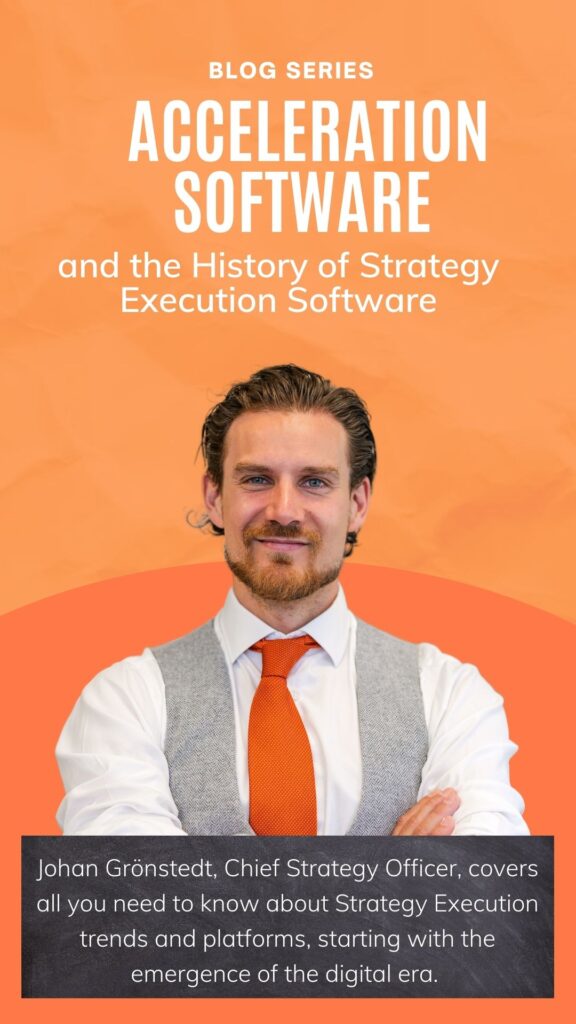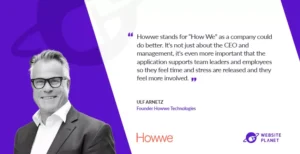Johan Grönstedt, Chief Strategy Officer, covers all you need to know about Strategy Execution trends and platforms, starting with the emergence of the digital era, also knows as the Reactive era.
In a series of three blog posts, we’ll dig into the history of strategy execution, trends, and platforms.
Generally speaking, strategy execution software has been around as long as strategies. This of course is not completely true, but with the emergence of the digital era, companies have been searching for the best way to get help from software when it comes to their strategy execution efforts.
Looking back at the last 25 years of digital platforms and their inherit traits, there are some clear trends. These can be divided into three different eras, where each and everyone will get a dedicated blog post. They are:
The History of Strategy Execution Blog Series
One can say that strategy execution software has been around as long as strategies. This might not be completely true, but with the emergence of the digital era, companies have been searching for the best way to get help from software when it comes to their strategy execution efforts.
In this blog series we’ve been looking back at some clear trends during the last decades and divided them into three different eras.
#1 The reactive era
General strategy execution
From 19XX to 2013
#2 The real-time era
Proactive Software
From 2013
#3 The proactive era
Provable Proactive Software
From 2018
In this post, we’ll go back in time to the emerge of the digital era when General Strategy Execution was dominating. The first use of what could be viewed as a strategy platform was software that digitally aggregated financial and operations output up to a CEO or Board of Directors.
This was, at the time, a big step. Before this, the information needed to be manually aggregated each week or month. Not only was this very time-consuming, but many companies struggled with very poor data quality. Most of this came down to an almost silly, but very human, impulse. Everyone wants to look good in front of their boss. So, when it was time to report the numbers, maybe 10 KPIs were chosen as important, and most team leaders would a) round the numbers up or b) only report the 6 out of 10 that were on track (failing to mention the 4 out of 10 that were behind).
When aggregated upward a beautiful (but not completely honest) picture was painted. To combat this systems engineers started idealizing a “single truth” – one system that would capture it all and never lie. Over time these types of systems were installed mostly everywhere and grew in scope to monitor and report on almost everything that went on in a company.
It was not a coincidence then that when CEOs started asking for a platform not only to get financial numbers reported in but to be able to push strategies out, these types of systems got there first (heavily backed by consultancy firms that saw multiple years of system-related support dependencies).

Examples of traditional applications are business scorecards, tools or games for behaviour change, or project management tools.
These systems supported what was trendy at the time. Here are some, but not all, of the traits that they had.
They support strategy transformation journeys that were at least 3, but most often 5 or even 7 years long.
The strategy was perceived to be only a long-term play. Bear in mind that this is in a “pre-disruption”-era when most strategy consultancy firms were pushing for core value work-overs and big market positioning plays. Every team in a company should have workshops on what the core values meant for them and build 1-3 year-long plans for how they should bridge the gap of their current culture alignment and the SWOT-analysis optimal play.
Engrained in this era of thinking was that as long as the strategic plan was perfect, the execution was not really the hard part. Time has over and over proven quite the opposite (it’s not the elegance of the plan, but the ability to execute it).
A couple of years later, it is almost frightening how much work was put into these workshops and how little provable financial effect they had.
Strategy execution is delegated very early to silos
Typically, the BoDs and the CEO were in charge of the WHAT but gave very little attention to the HOW or the WHY. This was up to the “management” to figure out.
Frustratingly, management tends to sub-optimize according to their own silo agenda, hugging all the investments but contributing as little new revenue as possible. 1+1 was never 3.
It was also increasingly difficult for “management” to get buy-in from their respective organizations when they were only armed with a budgetary target and some vague, consultancy-generated market position and core values.
There were therefore as many “strategies” as there were managers and many companies struggled with coherence within the company (funnily enough fueling the 2000’s trend for the management consultants of building brand new ONE COMPANY consolidation strategies…)
To capture and govern all was better than prioritizing the most important – leading to too many KPIs
Since these systems were installed to order to monitor as much of the operations as possible, dashboarding and reports were often a confusing affair. Hundreds of datapoints were generated and could be presented to different users at different levels resulting most often in information overload for the user.
A common solution to this confusion was to build different sorts of balanced scorecards. This type of dashboard included almost everything of interest but stacked the data in a way that was understandable to the user.
Still today, these types of dashboards are in use the world over and excel at painting a broad picture of performance. They struggle, however, with the concept of priority. Most balanced scorecards are built on between 10-40 KPI-points, leading the user to struggle to understand if KPI 34 or 12 is what is truly important to improve.
The consensus today is that, although monitoring is needed on a lot of business KPIs, when it comes to strategy execution platforms, they must support the user directly when it comes to prioritizing what is most important in order to gain real improvements. Generally speaking, there is an inverse relationship between the number of priorities (KPIs) and the success rate of the strategy.
A secondary, more contemporary, criticism of balanced scorecards is that they place an over-emphasis on KPIs of secondary importance to financial performance. They have a tendency to focus teams on increased service satisfaction scores or employee engagement indexes, rather than on prioritized business crucial improvements.
Ultimately, this type of software is good at some things (mostly monitoring) but not suitable for other things. One frustration a lot of business leaders have with them is that they only capture historic events and data. They are reactive in nature. They are not ideal to drive change or an increase of focus. They do not support leaders or employees to succeed better tomorrow than they are today.
Stay tuned for the next post in the blog series about Strategy Execution Software, where Johan Grönstedt will take you on a journey through the trends and platforms of the real-time era.
Behind this blog-series is Howwe. But who is Howwe? And who is Howwe for?
Do you have several teams, departments, and leaders? And you want to accelerate your growth? Then you will most certainly benefit from Howwe. We’ve seen success across all sectors and industries. Do you want to see some examples? Check out some of our customers or explore some of the other sectors we support below. And don’t forget to watch our product demo.
We have a proven track record of supporting real estate companies in connecting their business plans to everyday operations. A proactive way of working supported by our SaaS application Howwe enables the full potential of your organization.
Many of the companies we support within the manufacturing and industrial sector struggle with implementation of their interdivisional and global transformation projects. With massive organizations, aligning the whole organization and making the business plan actionable on all levels is challenging.
Howwe supports many of the world’s largest healthcare companies, such as MSD, Amgen and GE Healthcare. Using Howwe, our customers achieve both organization-wide transformation and acceleration of financial results.
Who is Howwe for?
Howwe is the company behind the CEO Poll. But who is Howwe for?
Do you have several teams, departments, and leaders? And you want to accelerate your growth? Then you will most certainly benefit from Howwe. We’ve seen success across all sectors and industries. Do you want to see some examples? Check out some of our customers or explore some of the other sectors we support below. And don’t forget to watch our product demo.

Real Estate
We have a proven track record of supporting real estate companies in connecting their business plans to everyday operations. A proactive way of working supported by our SaaS application Howwe enables the full potential of your organization.

Industrial & Manfacturing Companies
Many of the companies we support within the manufacturing and industrial sector struggle with implementation of their interdivisional and global transformation projects. With massive organizations, aligning the whole organization and making the business plan actionable on all levels is challenging.

Healthcare
Howwe supports many of the world’s largest healthcare companies, such as MSD, Amgen and GE Healthcare. Using Howwe, our customers achieve both organization-wide transformation and acceleration of financial results.





